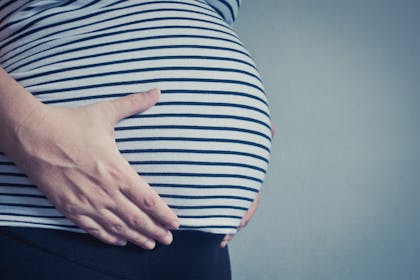Formerly known as Symphysis Pubis Dysfunction (SPD), pelvic girdle pain (PGP) affects one in five pregnant women. We look into what causes it and key symptoms to look out for. Plus, how physiotherapy and support belts can help treat it.
This page contains affiliate links, which means we may earn a small amount of money if a reader clicks through and makes a purchase. All our articles and reviews are written independently by the Netmums editorial team.
If you're experiencing pelvic pain during your pregnancy, you're not alone.
According to the Royal College of Obstetricians & Gynaecologists (RCOG) , it affects one in five mums-to-be.
Although it can be painful and sometimes even excruciating, spotting the signs and symptoms early on means you can start treating it before it gets worse.
FREE NEWBORN NAPPIES
Here's what you need to know about this unpleasant pregnancy condition.
What is pelvic girdle pain (PGP)?
Formerly known as Symphysis Pubis Dysfunction (SPD), the NHS describes pelvic girdle pain (PGP) as:
'A collection of uncomfortable symptoms caused by a stiffness of your pelvic joints or the joints moving unevenly at either the back or front of your pelvis.'
It's thought to be caused by pregnancy hormones relaxing the ligaments in your pelvic girdle (the bones making up your pelvis). This enables your baby to fit and engage into your pelvis as it nears your due date.
Although this is a good thing that's necessary for giving birth, your pelvis – in particular the symphysis pubis joint that links the two halves of your pelvis together – is usually quite a rigid joint.
As it becomes more mobile, moving up and down as you walk, it can cause tenderness, pain and discomfort.
The weight of your growing baby, poor posture and previous pelvis or back injuries can also all contribute to PGP.
What are the signs and symptoms of PGP?
Women with PGP describe it as a 'wrenching' or 'tearing' pain, as if your pelvis is tearing apart as you walk or move.
According to RCOG, key symptoms to look out for are:
- pain in the pubic region, lower back, hips, groin, thighs or knees
- clicking or grinding in the pelvic area
Symptoms also include pain made worse by movement, for example:
- walking on uneven surfaces/rough ground or for long distances
- moving your knees apart, like getting in and out of the car
- standing on one leg, like climbing the stairs, dressing or getting in or out of the bath
- rolling over in bed
- having sex
What's the treatment for PGP?
The NHS says that 'getting diagnosed as early as possible can help keep pain to a minimum and avoid long-term discomfort.'
So, if you suspect that you have SPD, talk to your midwife or GP about it. They'll be able to refer you to a physiotherapist who's specialised in pelvic joint problems for treatment.
Although physio won't cure it, it should help to improve your symptoms and ease discomfort.
According to the NHS, likely treatment for PGP will include:
- manual therapy to make sure the joints of your pelvis, hip and spine move normally
- exercises to strengthen your pelvic floor , stomach, back and hip muscles
- exercises in water
- advice and suggestions, including positions for labour and birth, looking after your baby and positions for sex
- pain relief, such as using a TENS machine
- equipment, if necessary, such as crutches or pelvic support belts (see below for more about these)
The Pelvic Obstetric & Gynaecological Physiotherapy Network (POGP) also offers advice on treating or relieving symptoms of SPD.
It recommends that you avoid:
- standing on one leg
- bending and twisting to lift, or carrying a baby on one hip
- crossing your legs
- sitting on the floor, or sitting twisted
- sitting or standing for long periods
- lifting heavy weights, such as shopping bags, wet washing or a toddler
- vacuuming
- pushing heavy objects, such as a supermarket trolley
- carrying anything in only one hand (try using a small backpack instead)
Coping with PGP at home: what else can I do?
According to RCOG, the following simple measures may help:
- keeping active but also getting plenty of rest
- standing tall with your bump and bottom tucked in a little
- changing your position frequently – try not to sit for more than 30 minutes at a time
- sitting to get dressed and undressed
- putting equal weight on each leg when you stand
- trying to keep your legs together when getting in and out of the car
- lying on the less painful side while sleeping
- keeping your knees together when turning over in bed
- using a pillow under your bump and between your legs for extra support in bed
How does wearing a support belt help?
Wearing a support belt can help take some of the pressure of your bump away from your pelvis and lower back. A good one will provide support to your pelvis.
Find more products for a smoother, more comfortable pregnancy .
What to Expect When You're Expecting by Heidi Murkoff is a must-read book for all expectant parents. See more details here at Amazon.
You can also buy it here at Waterstones.
Is it safe to take painkillers for PGP?
The only painkiller considered 'safe' in pregnancy is paracetamol – and that's as long as it's taken for the lowest dose for the shortest duration.
If your PGP is severe, talk to your doctor before taking painkillers. Although it's possible to be prescribed codeine to help with the pain, you'll have to be closely monitored while taking it.
Anti-inflammatory painkillers, such as ibuprofen are not generally recommended in pregnancy. And it's important to avoid aspirin during pregnancy, as it's not safe for your baby.
Can I still have sex with PGP?
Yes, you can still have sex if you find it comfortable.
NHS advice suggests that you:
'Find a comfortable position which allows you to keep your legs closer together (for example, lying on your side with your partner behind you).'
Check out our pregnancy kamasutra for more ideas for pregnancy-friendly sex positions.
Coping with PGP when you also have a toddler
Looking after yourself when you're pregnant is one thing but it can be tricky if you have a toddler to look after during your pregnancy.
Although it's not easy, NHS North Bristol maternity services recommend trying to follow these rules to help your PGP with a toddler in tow:
- Try to avoid lifting your toddler too often and avoid carrying the child on one hip
- If they want a cuddle, sit down and ask the child to sit beside you or on your lap
- Remember to let the cot side down when lifting the child in/out (bend your knees, keep back straight)
- Kneel to bath your child (don't bend over the bath) or preferably ask a partner/relative to help
- Keep your child close to you when lifting them into a car seat (have the front seat pushed well forward to allow more room).
- Rest as much as possible
Coping with PGP at work
RCOG suggests telling your boss if your have PGP pain as it could affect your job. It says:
'If you work, talk to your employer about ways to help manage your pain. You shouldn’t be sitting for too long or lifting heavy weights.
'You may want to consider shortening your hours or stopping work earlier than you had planned if your symptoms are severe.'
NHS North Bristol maternity services offers this advice for working mums-to-be with PGP:
'Ask your manager for a risk assessment of your workstation and workplace tasks.
'If you are an office worker, you should have a supportive, adjustable chair and try to stand up/walk a little every 30 minutes.
'If your work involves standing/ walking, you should have a few minutes rest sitting down every 30 minutes.'
Will PGP affect the baby?
No, according to RCOG, 'although it can be very painful for you, it will not harm your baby.'
Will PGP affect my labour?
According to RCOG, 'most women with pelvic pain in pregnancy can have a normal vaginal birth.'
In fact, having a C-section isn't recommended.
According to NHS North Bristol maternity services:
'There is no evidence that an elective (planned) caesarean section has any additional benefit nor that it will improve recovery or the chances of PGP recurring in future pregnancies.'
The NHS suggests that you flag up your PGP with your midwife and discuss your birth plan with them in advance.
Although you'll be eligible for all forms of pain relief, the NHS also recommends women with PGP try a water birth :
'Being in water can take the weight off your joints and allow you to move more easily, so you might want to think about having a water birth.'
Will I still have PGP once I've given birth?
The good news is that most cases of pregnancy-related PGP get better or disappear once you've had the baby.
'This is because the weight of the baby is no longer affecting the pelvic joints,' explains NHS North Bristol maternity services.
According to RCOG, only one in 10 will have continued pain after giving birth.
However, you may need to continue with exercises and physiotherapy, especially if your PGP pain continues.
According to NHS North Bristol maternity services, 'it is still important to follow the advice given for pregnancy, as the ligaments take at least four-five months to return to their pre-pregnancy condition.'
It recommends that you:
- gradually increase your walking distance and activity levels
- start doing your pelvic floor exercises again as soon as you feel comfortable after the birth
- if your PGP is not settling within 4 weeks of the birth, ask to be referred to a women’s health physiotherapist
How will PGP affect future pregnancies?
According to RCOG:
'If you have had PGP, you are more likely to have it in a future pregnancy.
'Making sure that you are as fit and healthy as possible before you get pregnant again may help or even prevent it recurring.
'Strengthening abdominal and pelvic floor muscles makes it less likely that you will get PGP in the next pregnancy. If you get it again, treating it early should control or relieve your symptoms.'
Are you suffering from PGP? Chat to other mums about your experience in our forum below:







